|
Rules
Download and Designer’s Notes
The Command
Horizon rules are designed to give you a quick and free-flowing game.
To give you an idea of what to expect please take a little time to read
the notes below. If you can’t wait that long you can download the
rules now and get playing the game!
The download
is Version 4.1 – April 2008. We are developing, improving and updating
the rules on a continuing basis, so please check regularly to make sure
that you have the latest version.
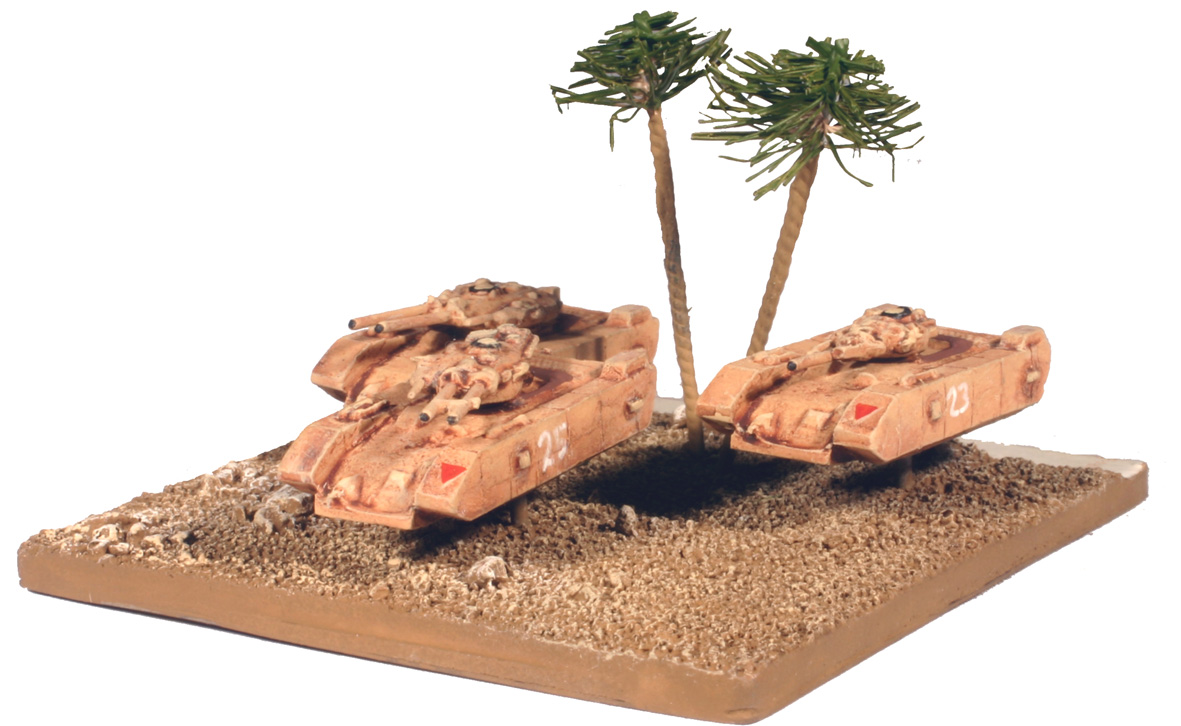
Introduction
There are
many Science Fiction/Future combat rules available for wargamers to use.
What makes Command Horizon different is their scale of action, scale of
figures used and level of complexity. There were clear objectives laid
out at the start of the process. The rules had to be:
* Suitable
for 6mm scaled figures and models.
* Simple to play, with a minimum of charts, tables and modifiers. We wanted
players to be able to pick up the mechanics after a couple of game turns.
* Offer the option to play large actions based on battalions as opposed
to the single figure mass-skirmish games that currently dominate the genre.
* Quick to play – a typical game to last no longer than 90 minutes.
* Set in a believable and realistic universe. No semi-mystical and baroque
weapons, lost cultures or other semi-fantasy concepts.
The end result
is the Command Horizon rules and universe. We have enjoyed creating both
and play testing and developing the rules, and we hope that you will enjoy
the games that it produces. As with any set of rules there are a large
number of assumptions and decisions about what is relevant and what we
have felt is unimportant that cannot be expressed in the simple statement
of how you play a game. These short notes are an attempt to give you some
insight into the why and how of the design process.
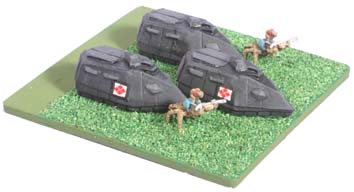
What You will need to play Command Horizon.
Your
Army
Command Horizon
puts you in charge of a battalion. This means that each model actual represents
a number of vehicles or men. This approach, while common in historical
gaming, has never been popular with SF games, where games are generally
played as ‘mass skirmishes’. We wanted to take the opportunity
that 6mm offers of giving the players command of large formations of men
and machines. The change of emphasis gives a very different game and offers
a refreshing change. There is nothing like the thrill of ordering several
thousand men into an an all-out assault. The change of command level also
allows us to shift the emphasis of the game mechanics from ’super-weapons’
and fancy armour, to the command and co-ordination of the different parts
of a combined arms force. If you are tired of seeing your carefully thought-out
plans thwarted by a single figure armed with a ‘Super Slayer Light
Sword of Doom’, then we think that CH could be the system for you.
Dice
and Markers
We have opted
for a ‘buckets of dice’ combat system. This was not the first
option by any means as we tried and discarded D10, single D6 and poly
dice. When it came down to it we found the multi-D6 roll enabled us to
develop an instinctive game mechanic based on identifying the weaponry
being used and rolling a number of dice based on that. This gets rid of
the need for multiple modifiers and tables. No matter how hard we tried
there was no way to eliminate some means of indicating a change of status
of a unit during the game. We have managed to keep this to a minimum,
but nonetheless it has to be done, and we have opted to do this with markers.
There are two types of wargamers. Those who like to keep a paper record
of roster sheet, this leaving the table clear of clutter, and those who
hate to have bits of paper lying around with badly written notes and crossings
out all over them. No matter which option we adopted we would have alienated
one section. If you are one of those people who say, ‘I will never
play a system that forces me to use markers on the table!’, can
I suggest that you give these rules at least one play. By refusing to
see how it works you may just be missing out. We have actually kept the
use of markers to an absolute minimum.
* Each battalion
must have an indication of its current Command Horizon for which we use
a small D6 placed on the battalion HQ base.
* At one point in the game a player must indicate which units receive
an allocation of Command Points. In our games we actually used singly
based Light Command Vehicle models.
* Similarly at one point in the procedure those units that have had a
Hit must be indicated. The use of black and white acrylic ‘pom-poms’
placed in the bases affected is simple and again doesn’t affect
the aesthetics of the game.
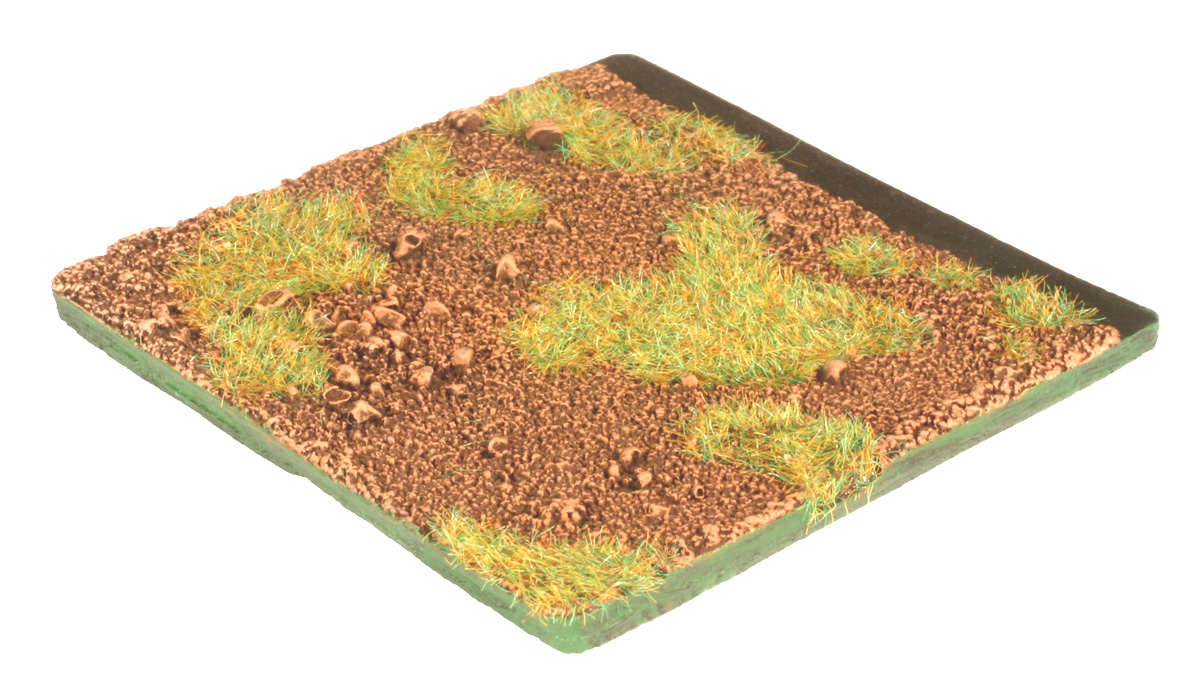 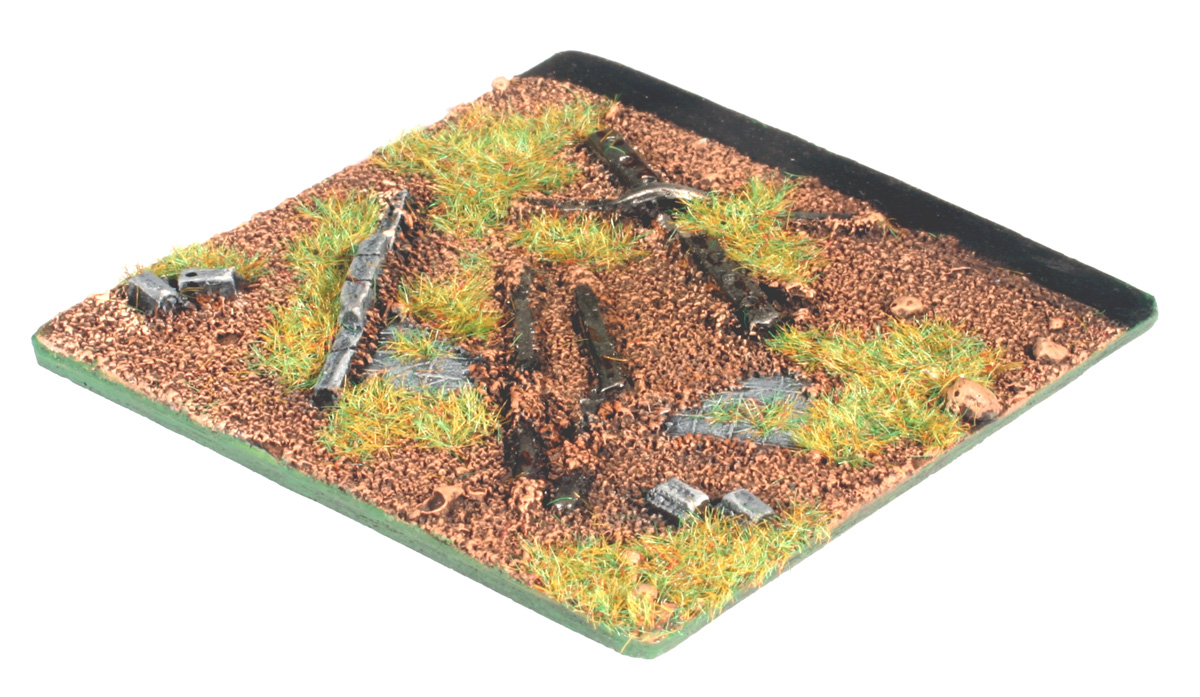 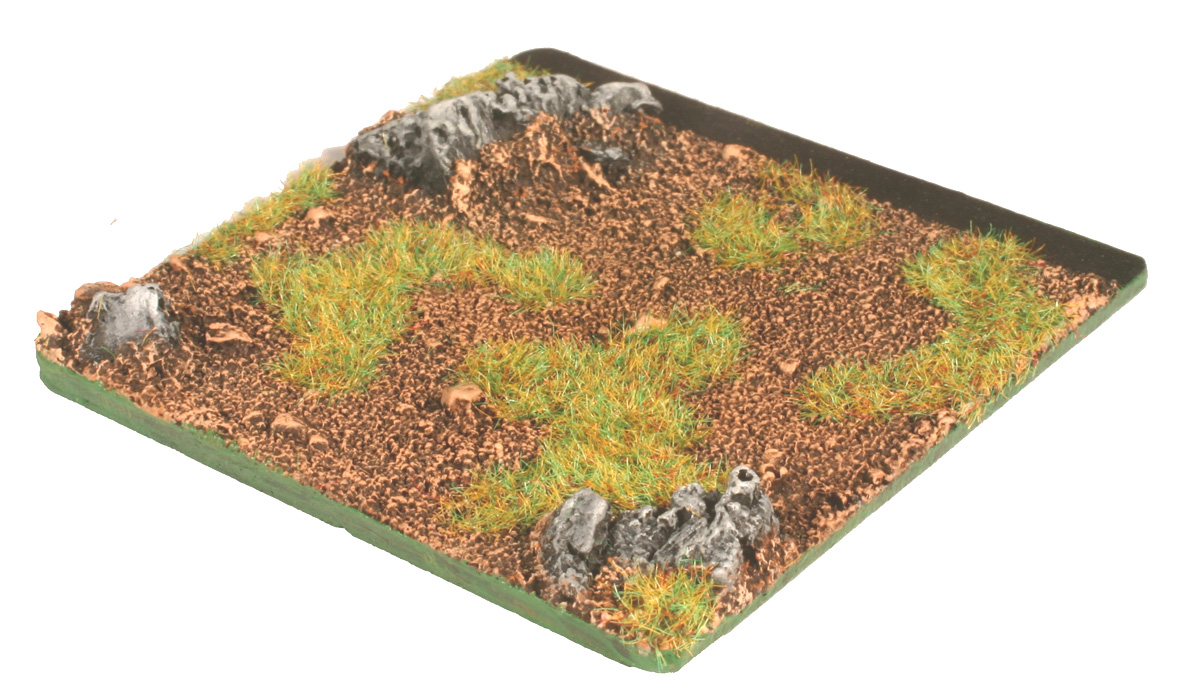
Textured resin bases available from Baccus
Bases and Measurements
Command Horizon
require all units to be placed on a base. The official size for this is
60mm square, but the system is easily usable for any size of base.Why
bases? Many existing SF rules sets work quite well with no bases for the
vehicles at all. The important point about CH is that the because the
models are representative, you need to give some indication of the ground
occupied by infantry or vehicles on the base. This can only be done by
allocating a fixed area of ground to a set number of models. A more practical
point is that it is much easier to move four bases, each holding three
models than it is to move twelve individual tanks
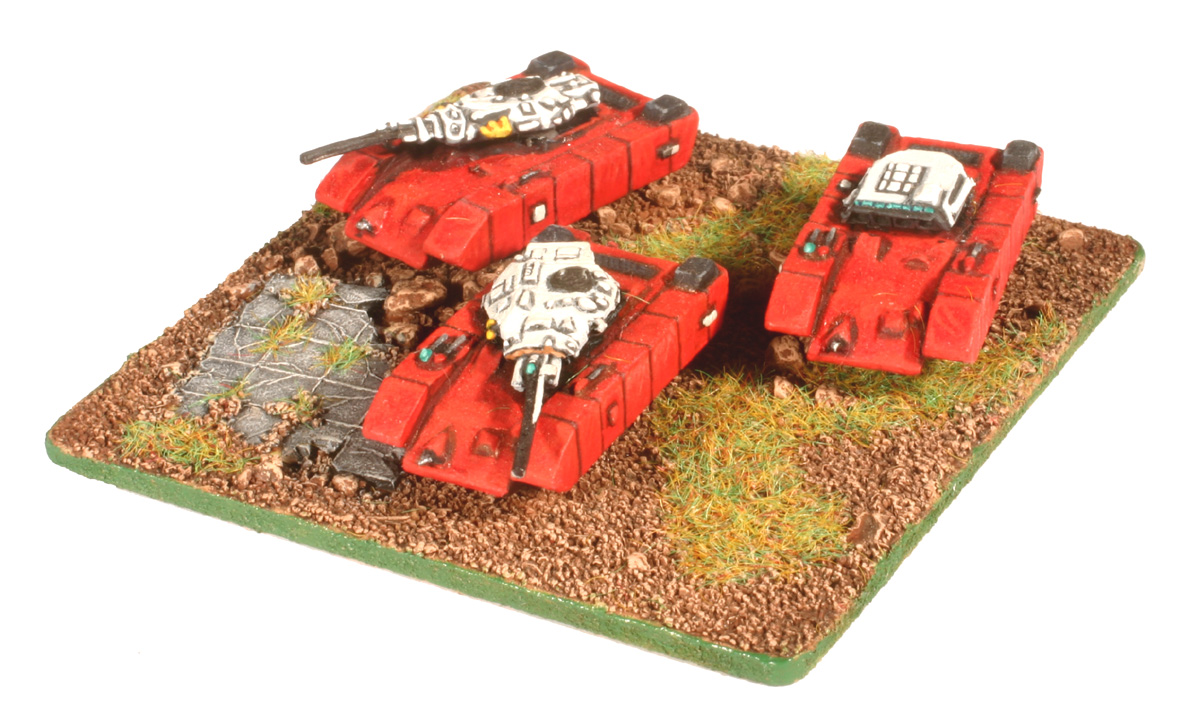
A company of medium tanks
The use of
fixed bases also confers a couple of other great advantages. By making
all measurements from edge of base to edge of base this removes ambiguity
and a great source of wargamer arguments and tantrums. It also means that
we have been able to standardise all measurements into multiples of a
base width. This simplifies the movement and range measurements, and importantly
allows for different basing standards to be used, provided both sides
are consistent. For example if your armies are already on 40mm bases then
they can be used with CH. Alternatively if you feel the need to move to
80mm square bases, this can be done with no alteration to the rules needed
at all.
Organising
Your Army
We decided
to keep the organisation of Human forces along traditional lines. Most
players will be familiar with Companies, Battalions and Brigades. Military
terminology tends to be very conservative in nature and we cannot see
these terms changing much, even after several hundred years. Aliens follow
similar patterns but have radically different command and control systems
making them a challenge to play and play against.
Unit
Types
Once again,
the range of arms available to a brigade commander remains familiar. The
types of armour and offensive weapons may have changed with the introduction
of technology, but the simple facts remain that you need offensive units
to take ground, infantry to hold it and both need support from air and
artillery support.The obvious exceptions are the Walkers, and as both
the Command Horizon rules and figure ranges develop more exotic and advanced
unit types will be introduced.
Weapons
and Equipment
The basic
tripartite division of long range offensive weapons includes the current
options of projectile firing guns and missile systems, along with that
staple of SF gaming and literature, a ‘ray gun’.In this edition
of Command Horizon, you will find that there is no real differentiation
between the effect of Guns and Beams. This is purely a temporary state
as future developments will see both being more closely defined with their
own strengths and weaknesses.Launchers have the great advantage of not
having their firing affected by blocked line of sight, but are subject
to greater interference from ECM.
Command
As much as
any army relies on good equipment, it can do nothing unless it has good
training, an efficient command structure and a competent person in charge.
All of this is reflected in the Command Horizon rating of the Battalion
and Brigade HQs. For Brigade HQs the CH value reflects the competence
of the Brigadier and his staff. It is also a function of the efficiency
of the collation and interpretation of the vast amount of electronic information
flowing into the HQ from the thousands of Battlefield Information Devices
that cover the combat area. For Battalion HQs the CH value is a measure
of the unit’s ability to interpret and act upon orders as well as
the efficiency of its internal command structure.
Playing
Command Horizon – Moving
Move
Sequence
The move
sequence is very straightforward being a variation on the standard IGO-UGO
system. Like all such processes it seems very complex when first viewed,
but after a couple of run throughs you’ll find it both easy to follow
and instinctive. The Reaction phase is the key section of any player’s
move. How the Command Points are allocated and which order they are used
in will make all the difference to the outcome of the game. We recommend
that all players take some thinking time when it comes to this part of
the move.
Movement
The most
controversial part of this section is that provided bases do not end up
on top of each other at the end of their move, neither friendly nor enemy
bases offer any barrier to movement. Remember that each base actually
represents a relatively small number of men or vehicles occupying a very
large area of ground. What we have found in play is that seemingly obvious
tactic of trying to drive through an opponent’s front line brings
no advantage at all and usually ends up with the offending player taking
a great deal of punishment as the exposed unit places itself in very close
range of a lot of defenders. Like many of the more controversial aspects
of the Command Horizon rules we suggest very strongly that you reserve
any criticism until you have actually played a game or two, as the practice
gained from this is by far a better means of judgment than condemnation
after a read-through.
Terrain
The terrain
rules are very simple. This scale of action covers large areas of ground,
so we don’t take into account single trees or buildings, just areas
of forests or built up areas. At the moment the rules are designed only
for temperate Earth-compatible environments. We will be adding extra sections
for more extreme environments later. These will include lower and higher
gravity, extreme climate and temperatures.
Playing
Command Horizon – Combat
Shooting
The Command
Horizon combat system is very simple. To some, the delight of a wargame
is that they can measure ranges, work out angles of deflection, arcs of
fire, exact ammunition being used, the morale of the firer, the type of
armour being engaged, the size of the target and the angle of the sun
in the firer’s eyes. Once all of these factors have been totalled
and three charts referenced dice are rolled and damage inflicted or not.
Damage can range from a scratch to the paintwork, to complete destruction
and invariably in such games this all ammunition expenditure has to be
recorded.We take a completely different approach. The debate about ‘realism’
vs ‘playability’ often concludes that you can only have one
at the expense of the other. We would beg to differ. Analyzing a single
shot in microscopic detail is just not feasible in a game such as CH when
we are dealing with the actions of hundreds of men at any one time.The
basis of the combat system is that when armour and defense cope with incoming
fire, they cope very well. When those defences are breached it can be
disastrous. The only state between fully operational and destroyed is
‘Zipped’. In this condition a base is treated as being completely
disrupted and thus can neither move nor conduct any offensive action.
Line of sight
As with movement,
Line of Sight is only blocked by terrain. It is not blocked by either
enemy or friendly units. Each base covers a large area which in reality
is occupied by a relatively small number of men and vehicles. We make
the assumption that advanced IFF systems and information from BIDs keep
friendly units from being incorrectly targeted
Additional
Units.
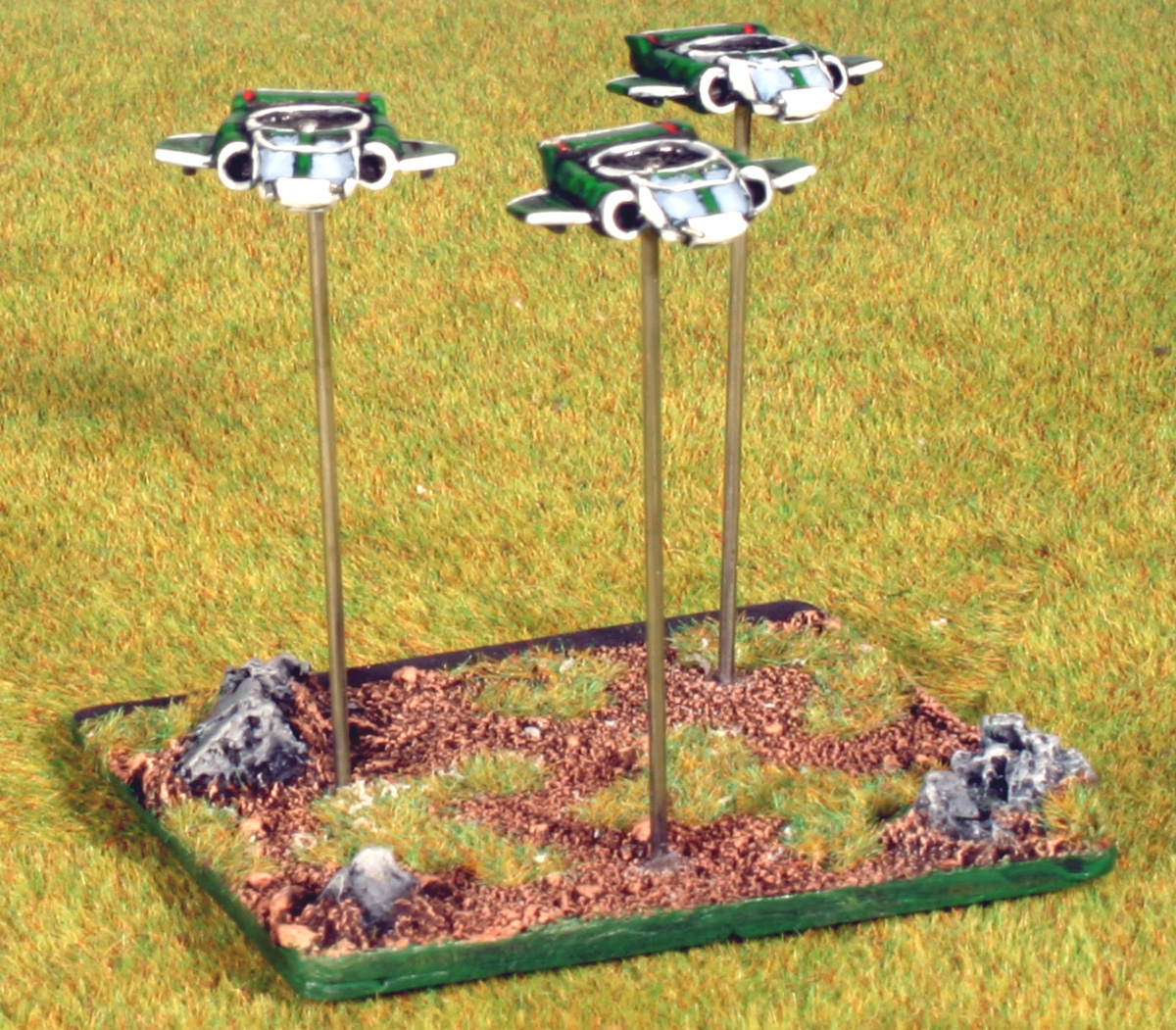
Human Skim Fighters
One of the
great joys of playing SF games is the opportunity to use units and weapons
that are not technologically possible at the present time. We have purposely
made the CH systems simple which will allow us to add increasingly exotic
machines and weapons. Although this section deals with the conventional
artillery and aircraft, it also sees the first of these future weapons
with the light walkers. The aim is to keep all such weapons feasible in
terms of our modern understanding of technology and materials, but to
give them qualities that will enable new tactics and armies to develop.
This process will accelerate as we introduce alien races to the CH universe.
|

